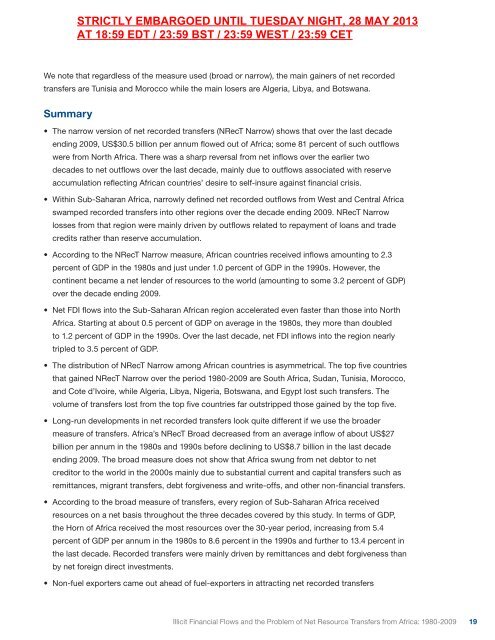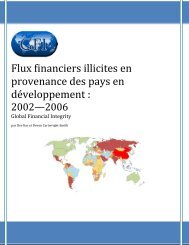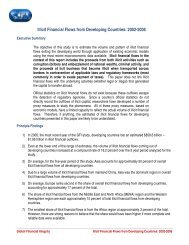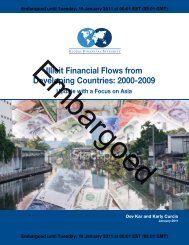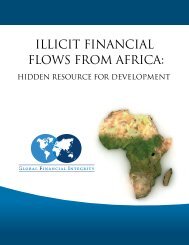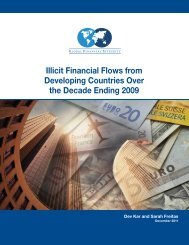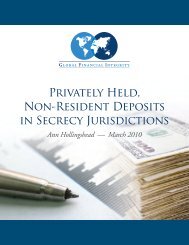Illicit Financial Flows
Illicit Financial Flows and the Problem of Net Resource Transfers ...
Illicit Financial Flows and the Problem of Net Resource Transfers ...
Create successful ePaper yourself
Turn your PDF publications into a flip-book with our unique Google optimized e-Paper software.
STRICTLY EMBARGOED UNTIL TUESDAY NIGHT, 28 MAY 2013<br />
AT 18:59 EDT / 23:59 BST / 23:59 WEST / 23:59 CET<br />
We note that regardless of the measure used (broad or narrow), the main gainers of net recorded<br />
transfers are Tunisia and Morocco while the main losers are Algeria, Libya, and Botswana.<br />
Summary<br />
• The narrow version of net recorded transfers (NRecT Narrow) shows that over the last decade<br />
ending 2009, US$30.5 billion per annum flowed out of Africa; some 81 percent of such outflows<br />
were from North Africa. There was a sharp reversal from net inflows over the earlier two<br />
decades to net outflows over the last decade, mainly due to outflows associated with reserve<br />
accumulation reflecting African countries’ desire to self-insure against financial crisis.<br />
• Within Sub-Saharan Africa, narrowly defined net recorded outflows from West and Central Africa<br />
swamped recorded transfers into other regions over the decade ending 2009. NRecT Narrow<br />
losses from that region were mainly driven by outflows related to repayment of loans and trade<br />
credits rather than reserve accumulation.<br />
• According to the NRecT Narrow measure, African countries received inflows amounting to 2.3<br />
percent of GDP in the 1980s and just under 1.0 percent of GDP in the 1990s. However, the<br />
continent became a net lender of resources to the world (amounting to some 3.2 percent of GDP)<br />
over the decade ending 2009.<br />
• Net FDI flows into the Sub-Saharan African region accelerated even faster than those into North<br />
Africa. Starting at about 0.5 percent of GDP on average in the 1980s, they more than doubled<br />
to 1.2 percent of GDP in the 1990s. Over the last decade, net FDI inflows into the region nearly<br />
tripled to 3.5 percent of GDP.<br />
• The distribution of NRecT Narrow among African countries is asymmetrical. The top five countries<br />
that gained NRecT Narrow over the period 1980-2009 are South Africa, Sudan, Tunisia, Morocco,<br />
and Cote d’Ivoire, while Algeria, Libya, Nigeria, Botswana, and Egypt lost such transfers. The<br />
volume of transfers lost from the top five countries far outstripped those gained by the top five.<br />
• Long-run developments in net recorded transfers look quite different if we use the broader<br />
measure of transfers. Africa’s NRecT Broad decreased from an average inflow of about US$27<br />
billion per annum in the 1980s and 1990s before declining to US$8.7 billion in the last decade<br />
ending 2009. The broad measure does not show that Africa swung from net debtor to net<br />
creditor to the world in the 2000s mainly due to substantial current and capital transfers such as<br />
remittances, migrant transfers, debt forgiveness and write-offs, and other non-financial transfers.<br />
• According to the broad measure of transfers, every region of Sub-Saharan Africa received<br />
resources on a net basis throughout the three decades covered by this study. In terms of GDP,<br />
the Horn of Africa received the most resources over the 30-year period, increasing from 5.4<br />
percent of GDP per annum in the 1980s to 8.6 percent in the 1990s and further to 13.4 percent in<br />
the last decade. Recorded transfers were mainly driven by remittances and debt forgiveness than<br />
by net foreign direct investments.<br />
• Non-fuel exporters came out ahead of fuel-exporters in attracting net recorded transfers<br />
<strong>Illicit</strong> <strong>Financial</strong> <strong>Flows</strong> and the Problem of Net Resource Transfers from Africa: 1980-2009<br />
19


